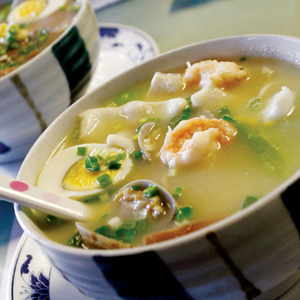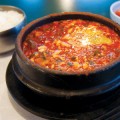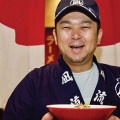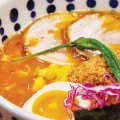I had planned to review a promising-looking Mexican restaurant in Palo Alto, but ran into technical difficulties and had to scratch it. Truth be told, the restaurant didn’t take credit cards (I hate that), and I was cashless and running late, and I didn’t want to spend the time searching out an ATM.
So I scratched the review of the Mexican restaurant and headed out of town. On the way, I passed a restaurant on El Camino Real that I had long been wondering about: Golden Wok/Fresh Taste.
The restaurant not only has two names, it also has two cuisines: Chinese and Japanese. In my experience, restaurants that offer two kinds of food under one roof are seldom good. Jack-of-all-trades, master of none, etc.
But what caught my eye was the banner touting the restaurant’s ramen. I’m always looking for a new outlet for real ramen, and a few minutes to spare, I stopped in to reconnoiter the menu and see if the place had potential.
I was encouraged by the variety of ramen on the menu. There were standards like shoyu and shio ramen, but also some Szechuan-inspired versions I had never seen before. Just then the owner, the woman who created these nontraditional bowls of ramen, asked me if I wanted to eat in or get something to go.
I didn’t have time to eat in the restaurant and hadn’t considered getting an order to go, but it suddenly struck me as a good idea. I could salvage my failed lunch outing and bring home a takeout for dinner. And they took credit cards. So I ordered the shoyu (soy sauce), asari (clam and butter) and mapo tofu ramen (all $7.95).
Now, let me say right here that getting ramen to go isn’t a good idea. The noodles are packed separately so they won’t get soggy in the broth, but they continue to steam and soften. I flipped open the lid while I drove away to allow some of the steam to escape, but it still compromised the noodles. The broth also cooks the vegetables, boiled eggs and other ingredients in the noodle soup beyond what they would have been had I eaten in the restaurant.
All of which is to say the ramen was solidly mediocre, with watery broth and mushy toppings. So I went back the next day and ate in the restaurant. I ordered the shoyu, asari, mapo, tan tan and vegetable ramen (I wasn’t alone). The results were decidedly mixed.
The restaurant itself is nothing special. The dining room is drab, and there’s the smell of wok oil hanging in the air. The shoyu and asari ramen were just as bland, with no depth of flavor. The baby bok choy and fat generous slices of pork in the shoyu were fresher, and the noodles of both chewier, but the dull-as-dust broth sealed the fate of these ramen. The vegetable ramen was even blander. It was really just a bowl of imperceptibly seasoned water with a handful of vegetables and soft tofu.
The ramen isn’t in the league of Santouka, Kahoo or Ramen Halu, artisanal bowls of noodles made with thick, pork-fat-clotted broths and premium ingredients. But all was not lost. The mapo tofu ramen is a riff on a Szechuan dish that combines ground pork and soft tofu in a fiery, Szechuan peppercorn sauce.
The chile and peppercorn heat helped amp up the flavor of the broth. The tan tan noodles are inspired by a famous Sichuan dish, dan dan noodles, a street-hawker meal of noodles in a spicy peanut sauce. Combining the moderately spicy, peanutty sauce into a bowl of ramen works. It would work even better had the broth been built on a better foundation.
With a greater commitment to the fundamentals of ramen, namely a deep, rich broth, Golden Wok/Fresh taste could compete in the competitive world of Silicon Valley ramen. But for now, it falls short in spite of a few interesting combinations. But it does take credit cards.

 Kansas Hate Group Threatens to Protest Local High School Play
Kansas Hate Group Threatens to Protest Local High School Play  Livefeed: The Big E
Livefeed: The Big E 


